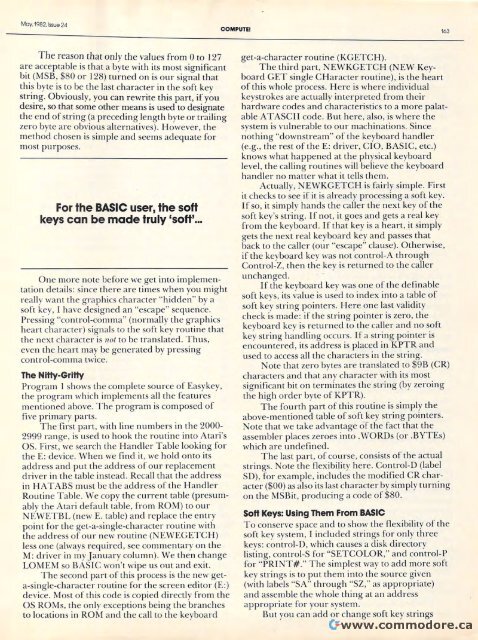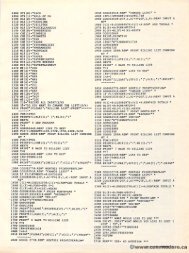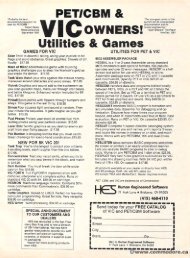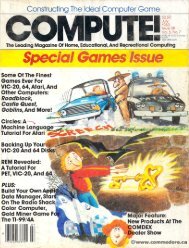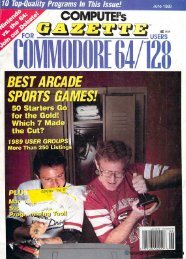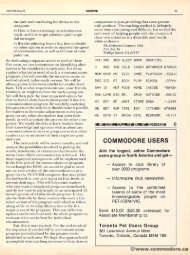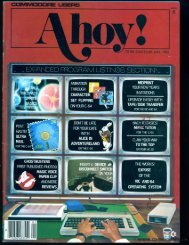Create successful ePaper yourself
Turn your PDF publications into a flip-book with our unique Google optimized e-Paper software.
May, May. 1982. Issue 24 2A<br />
COMPUTE!<br />
COMPUTEI 163<br />
The reason that only the values from 0 to 127<br />
are acceptable is that a byte with its most significant<br />
bit (MSB, (MSB: $80$ 0 or 128) turned on is our signal that<br />
this byte is IS to be the last character in the soft key<br />
string. Obviously, ObvIOusly, you can rewrite this part, if you<br />
desire, so that some other means is used to designate<br />
the end of string stnng (a preceding length byte or trailing<br />
zero byte are obvious alternatives). However, the<br />
method chosen is simple and seems adequate for<br />
most purposes. pu For the BASIC user, the soft<br />
keys can be made truly 'soft'...<br />
For the BASIC user, the soft<br />
keys can be made truly 'soft'...<br />
One more note before we get into implementation<br />
details: since there are times when you u might<br />
really<br />
y want the graphics character "hidden" by a<br />
soft key, I have designed an "escape" sequence.<br />
Pressi ng "control-comma" (normally the graphics<br />
Pressing "control-comma" (normally the graphics<br />
heart character) signals to the soft key routine that<br />
the next character is not /101 to be translated. Thus,<br />
even the heart may be generated by pressing<br />
even the heart may be generated by pressing<br />
control-comma twice.<br />
The NIHy·GrIHy<br />
Nitty-Gritty<br />
Program I shows the complete source of Easykey,<br />
Program 1 shows the complete source of Easykey,<br />
the program which implements all the features<br />
mentioned above. The program is composed of<br />
five primary parts.<br />
mentioned above. The program is composed of<br />
five primary parts.<br />
The first part, with line numbers in the 2000-<br />
2999 range, is used to hook the routine into Atari's<br />
OS. First, rirst, we search the Handler Table looking for<br />
the E: device. When we find it, we hold onto its<br />
address and put the address of our replacement<br />
driver in the table instead. Recall that the address<br />
in HATABS H must be the address of the Handler<br />
Routine Table. We copy the current table (presum<br />
Routine Table. We copy the current table (presumably<br />
the Atari default table, from ROM) to our<br />
ably the Atari default table, from ROM) to our<br />
NEWETBL (new E. table) and replace the entry<br />
point for the get-a-single-character routine with<br />
poi nt for the get-a-single-character routine with<br />
the address of our new routine (NEWEGETCH)<br />
less one (always required, see commentary on the<br />
M: driver in my January column). We then change<br />
LOM EM so BASIC won 't wipe us out and exit.<br />
LOMEM so BASIC wont wipe us out and exit.<br />
The second part of this process is the new geta-single-character<br />
routine for the screen editor (E:)<br />
device. Most of this code is copied directly from the<br />
OS ROMs, the only exceptions being the branches<br />
to locations in RON! and the call to the<br />
get-<br />
keyboard<br />
to locations in ROM and the call to the keyboard<br />
get-a-character routine (KGETCH).<br />
The third part, NEWKGETCH (NEW Keyboard<br />
GET single CHaracter routine), is the heart<br />
of this whole process. Here is where individual<br />
keystrokes are actually interpreted from their<br />
hardware codes and characteristics charaCleristics to a more palatable<br />
ATASCIIA TASCll code. But here, also, is where the<br />
system is vulnerable to our machinations. Since<br />
nothing "downstream" of the keyboard handler<br />
(e.g., the rest of the E: driver, CIO, BASIC, etc.)<br />
knows what happened at the physical keyboard<br />
level, the calling routines will believe the keyboard<br />
handler no matter what it tells them. thcm.<br />
Actually, NEWKGETCH t is fairly simple. First<br />
it checks to see if it is already processing a soft key.<br />
If I f so, it simply hands the caller the next key of the<br />
soft key's string. IfI f not, it goes and gets a real key<br />
from the keyboard. If that key is a heart, it simply<br />
gets the next real keyboard key and passes that<br />
back to the caller (our "escape" clause). Otherwise,<br />
if the keyboard key was not control-A through<br />
Control-Z, then the key is returned to the caller<br />
unchanged.<br />
If the keyboard key was one of the definable<br />
soft keys, its value is used to index into a table of<br />
soft key string pointers. Here one last validity<br />
check is made: if the string pointer is zero, the<br />
keyboard key is returned to the thc caller and no soft<br />
key string handling occurs. IfI I' a string pointer is<br />
encountered, its address is placed in KPTR and<br />
used to access all the characters in the string.<br />
Note that zero bytes are translated to $9B (CR)<br />
characters and that any character with its most<br />
significant bit on terminates the string (by zeroing<br />
the high order byte of KPTR).<br />
The fourth part of this routine is simply the<br />
above-mentioned table of soft key string pointers.<br />
Note that we take advantage of the fact that the<br />
assembler places zeroes into .WORDs (or .BYTEs)<br />
which are undefined.<br />
The last part, of course, consists of the actual<br />
strings. Note the flexibility here. Control-D (label<br />
SO), SD), for example, includes the modified CR character<br />
($00) as also its last character by simply turning<br />
onn the MSBit, producing a code of $80.<br />
Soft Keys: Using Them From BASIC<br />
Soft Keys: Using Them From BASIC<br />
To conserve space and to show the flexibility of the<br />
soft key system, I included strings for onlyy three<br />
keys: control-D, which causes a disk directory<br />
listing, control-S for "SETCOLOR," and control-P<br />
for "PRI NT#." The simplest way to add more soft<br />
for "PRI NT#." The simplest way to add more soft<br />
key strings is to plllthem put into the source givenn<br />
(with labels "SA" through "SZ," as appropriate)<br />
and assemble the whole thing at an address<br />
appropriate for your system.<br />
But youu can add or change soft key strings


